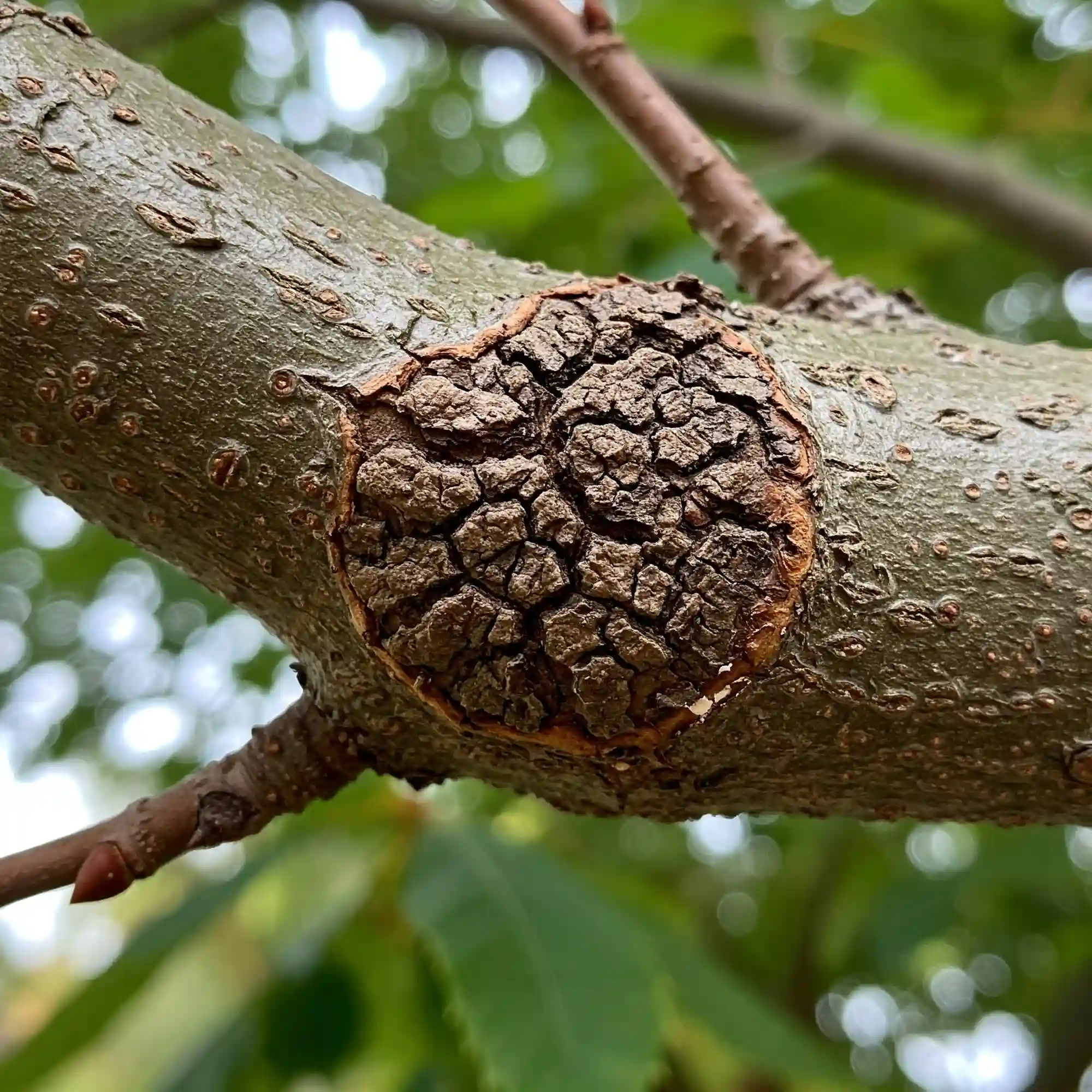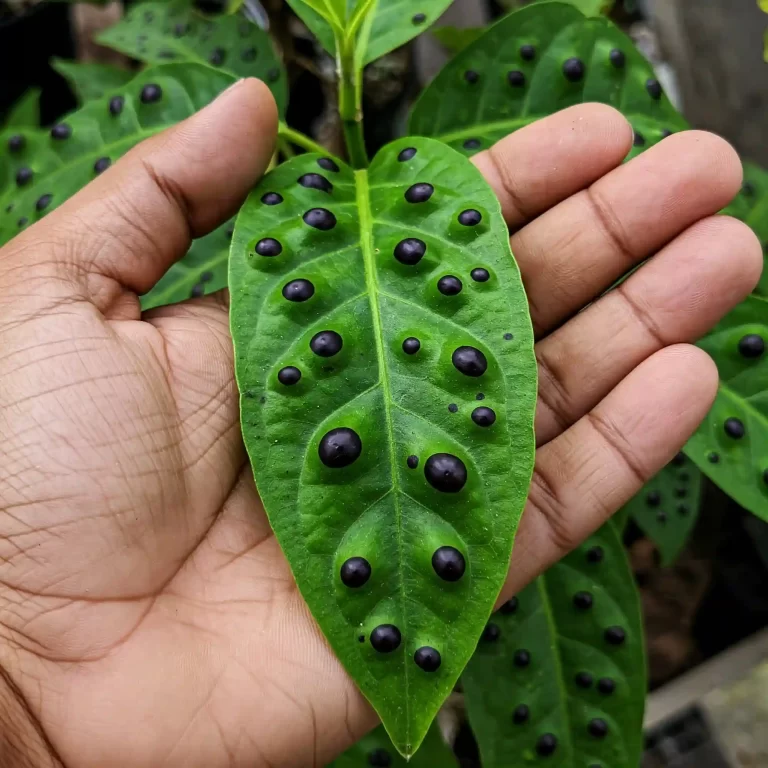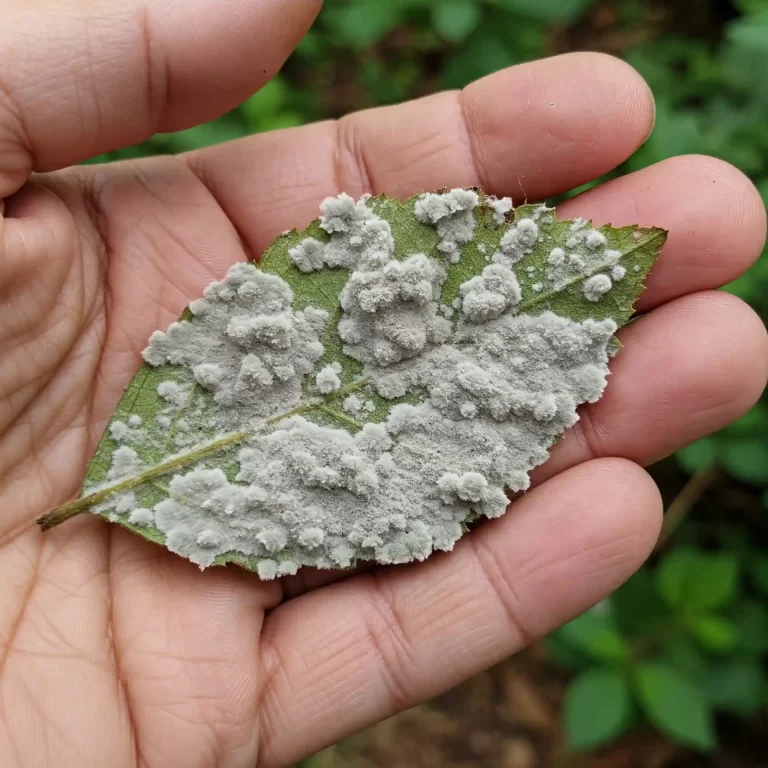Are you noticing unusual cankers on your beloved chestnut trees, watching their once vibrant leaves wither and die? It’s a heartbreaking sight, isn’t it? The fear of losing these majestic trees, the silent giants of our landscapes, can be overwhelming. You’re not alone. I’ve seen the despair of fellow gardeners as they grapple with the relentless spread of chestnut blight. But there’s hope. Together, we can learn to identify, prevent, and manage this disease, protecting our trees and preserving their legacy for generations to come.
Understanding Chestnut Blight
Chestnut blight is a devastating fungal disease that primarily affects chestnut trees, particularly the American chestnut (Castanea dentata). It is caused by the invasive fungal pathogen Cryphonectria parasitica. This fungus attacks the inner bark of the tree, disrupting the flow of nutrients and water, leading to the formation of cankers.
Cankers are open, sunken lesions on the bark of the tree. They can range in size from small, inconspicuous spots to large, girdling lesions that encircle the entire trunk or branch. The fungus enters the tree through wounds in the bark, such as those caused by pruning, insect damage, or other injuries. Once inside, the fungus grows and spreads, destroying the cambium layer, which is responsible for transporting nutrients and water throughout the tree.
The impact of chestnut blight on American chestnut trees has been catastrophic. Before the arrival of the blight in the early 1900s, American chestnuts were a dominant tree species in eastern North American forests. They provided valuable timber, food for wildlife, and played a vital role in the forest ecosystem. However, the rapid spread of the disease led to the near-extinction of the American chestnut.
The blight originated in Asia, where chestnut trees have evolved some level of resistance to the fungus. When the fungus was introduced to North America, the American chestnut trees had no natural defenses against it. The result was a devastating epidemic that decimated populations across the eastern United States.
Understanding the nature of chestnut blight, its cause, and its impact on the forest ecosystem is crucial for developing effective management strategies and protecting chestnut trees from this devastating disease.
Identifying Chestnut Blight in Your Trees
Regular inspections are your first line of defense in identifying and managing chestnut blight. I recommend conducting thorough visual examinations of your chestnut trees, especially during the growing season when symptoms are more pronounced.
Here are some key things to look for:
- Cankers: Carefully inspect the bark of the tree for any signs of cankers. Cankers are sunken or swollen areas on the bark, often with a reddish-brown discoloration. They may appear on branches, twigs, and the main trunk.
- Dieback: Observe the branches and twigs for signs of dieback. This occurs when the tips of branches or entire branches begin to die and turn brown or black.
- Leaf Wilting and Yellowing: Examine the leaves for signs of wilting or yellowing. This can indicate that the tree is not receiving adequate water and nutrients due to the disruption of the vascular system caused by the blight.
- Reduced Nut Production: A significant reduction in nut production compared to previous years can also be a sign of infection.
Early detection is crucial when dealing with chestnut blight. The sooner you identify an infection, the better your chances of managing the disease and preventing further spread. Early detection allows you to implement control measures, such as pruning out infected branches or applying appropriate treatments.
Remember, early detection is your best defense against the devastating effects of chestnut blight. By conducting regular inspections and paying close attention to the health of your chestnut trees, you can take proactive steps to protect these valuable trees.
Preventing the Spread of Chestnut Blight
Sanitation practices are your first line of defense in preventing the spread of chestnut blight. By following proper hygiene protocols, you can significantly reduce the risk of transmitting the disease to healthy trees.
Here are some key sanitation practices to follow:
- Disinfect pruning tools: After pruning an infected tree or any tree in the vicinity, thoroughly disinfect your pruning tools. You can use a solution of one part bleach to nine parts water or a commercial disinfectant. Be sure to clean all surfaces of the tools, including the blades, handles, and any other parts that may have come into contact with the tree.
- Avoid moving firewood: Do not move firewood from areas where chestnut blight is present to uninfected areas. Firewood can harbor the fungal spores that cause the disease. If you must transport firewood, obtain it from certified heat-treated sources or burn it where you acquire it.
- Clean equipment and clothing: After working with chestnut trees, clean your boots, clothing, and any other equipment that may have come into contact with the trees. This will help prevent the accidental spread of fungal spores.
In addition to these sanitation practices, planting resistant chestnut varieties can also help prevent the spread of chestnut blight. Resistant varieties have been developed through breeding programs that cross American chestnut trees with blight-resistant Chinese chestnut trees. These trees are less susceptible to infection and can help to reduce the impact of the disease.
By following these preventative measures, you can play a crucial role in protecting your chestnut trees and preventing the further spread of this devastating disease. Remember, even small actions can make a big difference in the fight against chestnut blight.
Additional Tips:
- When pruning infected trees, avoid pruning during wet weather, as this can increase the risk of spore dispersal.
- Use clean pruning tools and avoid wounding the tree unnecessarily.
- Keep your chestnut trees healthy through proper watering, fertilization, and pest control. Healthy trees are better able to resist disease.
By following these guidelines and practicing good sanitation habits, you can help protect your chestnut trees and contribute to the conservation of this valuable species.
Managing Chestnut Blight Infection
Managing a chestnut blight infection requires a multifaceted approach. While there is no single cure, several strategies can help control the disease and minimize its impact on your trees.
One of the most common management techniques is canker removal. This involves carefully pruning out infected branches or removing the canker itself from the trunk of the tree. However, it is crucial to exercise caution when removing cankers. Improper removal can spread the disease further, so it is best to consult with a certified arborist or tree expert for assistance.
Biological control is another promising approach to managing chestnut blight. This method involves introducing hypovirulent strains of the Cryphonectria parasitica fungus to the infected tree. Hypovirulent strains are weaker strains of the fungus that can infect and weaken the more virulent strains that cause the disease. This can help to reduce the severity of the infection and allow the tree to compartmentalize the damage, preventing further spread.
While these management techniques can help control chestnut blight, it is important to remember that there is no guaranteed cure. The goal is to minimize the impact of the disease and help the tree survive. Regular monitoring and prompt action are crucial for managing chestnut blight effectively.
Additional Considerations:
- Tree Health and Vigor: Maintaining the overall health and vigor of your chestnut trees is crucial for their ability to resist disease. Provide adequate water, fertilize appropriately, and protect them from other stressors such as drought, insect infestations, and excessive pruning.
- Research and Development: Ongoing research efforts are focused on developing blight-resistant chestnut varieties through breeding programs and genetic engineering. These efforts offer hope for the long-term survival of the American chestnut and the restoration of healthy chestnut populations in our forests.
By implementing these management strategies and staying informed about the latest research and developments, you can play a role in protecting your chestnut trees and helping to preserve this iconic species.
Protecting Your Chestnut Trees
Maintaining the overall health and vigor of your chestnut trees is a crucial step in protecting them from chestnut blight. Healthy trees are better equipped to withstand diseases and other stressors. By providing your trees with the proper care, you can significantly improve their resilience and ability to fight off infections.
Here are some key practices to ensure the health and vigor of your chestnut trees:
- Proper Watering: Water your chestnut trees regularly, especially during periods of drought. However, avoid overwatering, as this can lead to root rot. Water deeply and infrequently to encourage deep root growth.
- Fertilization: Fertilize your trees annually with a balanced fertilizer to provide essential nutrients. Avoid over-fertilizing, as this can weaken the tree and make it more susceptible to disease.
- Stress Reduction: Minimize stress on your chestnut trees by avoiding excessive pruning, protecting them from physical damage, and managing insect and pest infestations. A healthy tree is better able to resist disease.
- Mulching: Apply a layer of mulch around the base of the tree to help retain moisture, regulate soil temperature, and suppress weeds. Be sure to keep the mulch away from the trunk to prevent rot.
By implementing these practices, you can help your chestnut trees thrive and increase their natural defenses against chestnut blight. Remember, a healthy tree is a strong tree, and a strong tree is better equipped to withstand the challenges of disease.
In addition to proper care, participating in local monitoring and early detection programs can also help protect your chestnut trees. These programs involve volunteers and citizen scientists who monitor chestnut trees for signs of infection. By participating in these programs, you can help to identify new outbreaks early and implement control measures promptly.
The Future of Chestnut Trees
The future of chestnut trees is bright, thanks to ongoing research and restoration efforts. Scientists are relentlessly working to develop blight-resistant chestnut varieties through innovative breeding programs and cutting-edge genetic engineering techniques. These efforts hold the promise of restoring the American chestnut to its former glory and reintroducing it to its native habitats.
Organizations like The American Chestnut Foundation are at the forefront of this restoration movement. They are dedicated to developing blight-resistant chestnut trees through a process known as backcrossing. This involves crossing American chestnut trees with blight-resistant Chinese chestnut trees and then backcrossing the offspring with American chestnut trees to maintain the desired characteristics while increasing blight resistance.
In addition to breeding programs, researchers are exploring other avenues for blight control, such as genetic engineering and the use of hypovirulent strains of the Cryphonectria parasitica fungus. These innovative approaches offer hope for creating blight-resistant chestnut trees that can thrive in the face of this devastating disease.
The restoration of American chestnut trees is not just about preserving a beloved species; it is about restoring the ecological balance of our forests. The American chestnut played a vital role in the forest ecosystem, providing food and habitat for wildlife. The loss of this species has had a significant impact on forest biodiversity and ecosystem function.
The vision of restoring the American chestnut to its former prominence is a long-term endeavor, but it is a goal worth pursuing. By supporting research efforts, participating in restoration projects, and protecting our existing chestnut trees, we can all play a role in ensuring the future of this iconic species.
Frequently Asked Questions About Chestnut Blight
What are the earliest signs of chestnut blight infection I should look for?
- Cankers: Keep a close eye on the bark for the development of cankers. These are sunken or swollen areas on the bark that often have a reddish-brown discoloration.
- Dieback: Observe the branches and twigs for signs of dieback, where the tips of branches or entire branches begin to die and turn brown or black.
- Leaf Wilting and Yellowing: Monitor the leaves for any signs of wilting, yellowing, or premature leaf drop, which can indicate that the tree is not receiving adequate water and nutrients due to the disruption of the vascular system.
Can I treat chestnut blight myself? While some management techniques can be implemented by homeowners, it’s crucial to remember that treating chestnut blight effectively often requires specialized knowledge and expertise.
- Canker Removal: If the infection is limited to a few branches, you might consider removing the cankers. However, this should be done carefully to avoid spreading the disease further. It’s best to consult with a certified arborist or tree care professional for guidance on proper canker removal techniques.
- Avoid DIY Treatments: Avoid applying any chemical treatments to the tree without consulting a professional. Some treatments may not be effective and could even harm the tree.
Are there any effective fungicides for controlling chestnut blight?
Currently, there are no fungicides registered for the control of chestnut blight on trees in the landscape. While some fungicides may temporarily slow the growth of the fungus, they are not considered effective long-term solutions.
How can I prevent the spread of chestnut blight if I have an infected tree?
- Sanitation: Practice strict sanitation measures to prevent the spread of the disease. Disinfect pruning tools between cuts using a solution of one part bleach to nine parts water or a commercial disinfectant.
- Firewood Management: Avoid moving firewood from infected areas to uninfected areas. Firewood can harbor the fungal spores and contribute to the spread of the disease.
- Avoid Pruning During Wet Weather: Pruning during wet weather can increase the risk of spore dispersal.
What is the role of hypovirulence in chestnut blight management?
Hypovirulence is a naturally occurring phenomenon where a weaker strain of the Cryphonectria parasitica fungus infects and weakens the more virulent strains that cause the disease. This can help to reduce the severity of the infection and allow the tree to compartmentalize the damage, preventing further spread. Researchers are exploring ways to harness this natural phenomenon to manage chestnut blight.
Remember, early detection, proper sanitation, and consulting with tree care professionals are key to managing chestnut blight effectively.
Conclusion
Chestnut blight is a formidable challenge, but it is not insurmountable. By understanding the disease, implementing preventative measures, and staying informed about ongoing research and management strategies, we can protect our chestnut trees and work towards a future where these majestic trees once again thrive in our forests.
Early detection is key. Regularly inspect your chestnut trees for signs of infection, such as cankers, dieback, and leaf discoloration. If you suspect an infection, consult with a certified arborist or tree care professional for proper diagnosis and treatment recommendations.
Practice good sanitation habits to prevent the spread of the disease. Disinfect pruning tools between cuts, avoid moving firewood from infected areas, and clean your equipment after working with chestnut trees.
Support ongoing research and restoration efforts. Organizations like The American Chestnut Foundation are working tirelessly to develop blight-resistant chestnut varieties and restore these trees to their native habitats. Consider supporting their efforts through donations or volunteer work.
Remember, protecting our chestnut trees is not just about preserving a beloved species; it is about safeguarding our forests and maintaining the ecological balance of our environment. By working together and taking proactive steps, we can ensure that the legacy of the American chestnut lives on for generations to come.
I hope this information empowers you to protect your chestnut trees and take action to conserve this valuable species. Remember, every effort, no matter how small, contributes to the greater goal of restoring the American chestnut to its rightful place in our forests.
Additional Resources:
- The American Chestnut Foundation: https://tacf.org/
- USDA Forest Service: https://www.fs.usda.gov/
If you have any further questions or concerns, please don’t hesitate to consult with a certified arborist or tree care professional.




